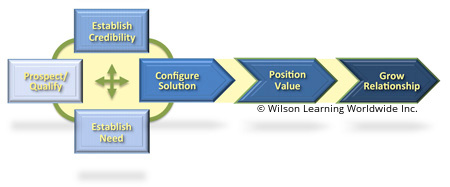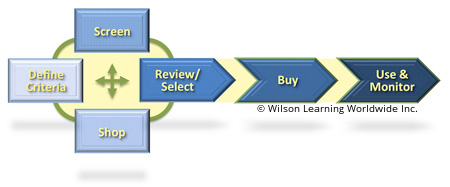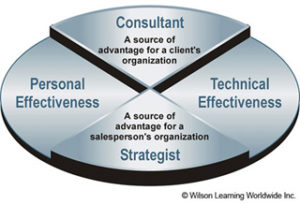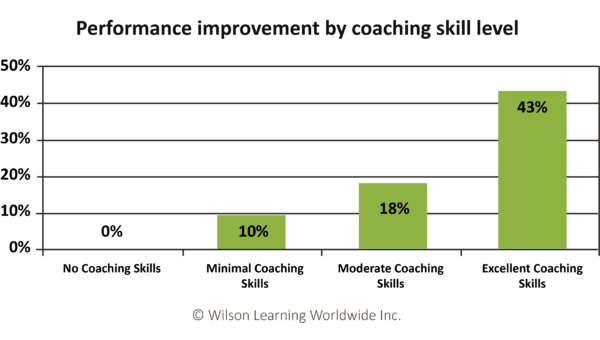Strategies for Peak Sales Performance
It is a struggle creating higher revenue with win rates falling, longer sales cycles, and a lack of sustainable sources of competitive advantage. But as products become more commoditized, innovations easier to replicate, and brand awareness less distinct and more expensive to create, where can organizations turn for that competitive advantage? The answer—the salesforce.
The Problem—A Lack of Sustainable Competitive Advantage
Traditionally, a company could win long-term advantages with new products, or dominate with deep pockets and massive size, or capture markets with widespread brand recognition and global presence. Today, these attributes may produce a temporary market advantage, but may also create a competitive disadvantage. It is not enough now to develop a new product to sustain advantage because:
- Competitors will quickly set about to replicate and leapfrog the technology, creating products with shorter and shorter shelf life.
- Deep pockets and economies of scale have quickly given way to agility and customization.
- Brand recognition, while important, loses its impact in an environment where new and improved competitors surface daily.
- Increased regulatory pressure means fewer opportunities for companies to differentiate themselves.
So how can organizations sustain competitive advantage under these conditions?
The truth is there are no sustainable competitive advantages anywhere on the business horizon anymore. The traditional sources of advantage, even the strategy to sustain advantage, have proven to be too static for today’s tumultuous marketplace. It is a short-term market requiring speed and organizational agility. Each day companies must regain the right to the customer’s business and regain the advantage over their competitors.
The Solution—Redefining Sales as a Source of Competitive Advantage
While there are no sources of sustainable competitive advantage left, we believe that one of the few remaining sources of renewable competitive advantage is the effectiveness of salespeople and sales managers. A recent study by Aberdeen found that the single largest business pressure concerning executives today is that “our products and brand are not distinctive enough to maintain customer loyalty.” Market dominance has become a function of how fast and how effectively companies can operate on behalf of the customer and, at the same time, show more agility and savvy than the competition. The degree to which sellers can make doing business with them easy and rewarding for customers, and impact the critical success factors of the customer’s business, is a measure of their competitiveness.
Selling has grown increasingly complex and difficult. As research by CSO Insights shows, win rates are down dramatically and the number of calls required to win have increased steadily. Further, even when a salesperson wins a deal, 62% of sales executives believe they are still “leaving money on the table.”
Being a source of competitive advantage requires a salesforce that has skills well beyond those of the past. It also requires sales management with both leadership character and management excellence. Current and future competitiveness requires anticipating the marketplace, not simply reacting quickly to customers.
3 Keys to Sales as a Source of Competitive Advantage
In the past, the successful salesperson was a persuader, a features expert, a detailer, or a challenger. This sales approach suited that environment, where customers had little information about providers, it was difficult to make direct product comparisons, and availability of products was always an issue.
Today is much different. Customers have almost too much information available; websites and consulting services are eager to provide product comparisons. Today’s customers find and screen providers before the providers even know there is a need. Customers are demanding that the salesperson justify the purchase in terms meaningful to the customer. As a result, successful salespeople become experts in their customers’ businesses, function as problem-solvers, and think more about the customer’s “buying process” and less about their own “sales process.”
In our experience and research, creating sales effectiveness requires three key elements:
- Aligning your sales process to the new customer buying process
- Balancing the Consultant and Strategist roles of a salesforce
- Ensuring sales managers add value
This paper examines each of these three elements and shows how each helps a salesforce serve as a source of competitive advantage.
Aligning the Selling and Buying Processes
The first key element is the need to align your sales process with the customer’s buying process.


New technology is changing the buying process. American Marketing Association reports that the vast majority of customers find sellers before sellers find the customer. Customers have multiple resources to identify, screen, and select vendors without contacting them and often reject sellers before the sellers even know they have been screened out. This is a significant change in how buyers buy and requires an equally significant change in how sellers sell.
Changes in the buying process are creating fundamental changes in the sales process. In the past, the sales process was the driver of the interaction between the customer and the seller. Salespeople prospected for new customers, led the identification of needs and requirements, proposed solutions, and “closed” a sale.
Today it is the buyer who is in charge of the speed and direction of the sale.
Customers do not follow a linear process. They gather information on available solutions and options and screen potential providers, and through that process continue to gather more information. They select only those they want to consider and use the providers’ knowledge to further refine their requirements. The use of decision teams rather than a single decision maker is the new norm, especially with strategically important buying decisions. There are multiple influencers, and most importantly, multiple people with “veto power.” But the buying process does not end there. Procurement departments frequently manage the actual purchase, gathering additional information and comparing the chosen offering to others on performance and price to ensure maximum value. And finally, buyers have found that they can ask for, and get, additional support and value-added services throughout their use of the product.
How does a salesforce differentiate in an environment like this? Successful ones have learned to adapt their sales process to the buyer’s buying process, aligning with how the customer wants to buy.
Key steps of the sales process have had to evolve along with the buying process.
Prospecting: Traditionally, prospecting focused on identifying and qualifying the buyer: Can this person make the decision? Do they have the financial resources? Prospecting today focuses more attention on qualifying the account: Will they buy and when will they buy? What is the seasonality to their buying cycle? What is their current performance and growth potential? How do they prefer to make decisions and how do they prefer to shop? Qualifying the contact has shifted to qualifying the buying decision team—their role in the decision process, predispositions, and personal motives.
Establishing Credibility: Successful salespeople position themselves and their organization as a trusted source of information and a trustworthy advisor long before the customer is ready to buy or has even identified the problem. Since organizations are pre-screening potential providers, a salesperson cannot wait until there is an identified need to approach a prospect; they need to get on the “must contact” list to even have a hope of making a sale.
Establishing Need: While needs-based discovery is still critical, in many situations it is not enough. Customers come to the needs discovery phase with already-defined criteria, and successful salespeople know how to use their industry and customer expertise to tie these needs to the organization’s strategy and critical success factors. Customers today know their requirements and criteria; what they need help with is aligning the costs of those requirements with business value, the ROI of making the purchase.
Configuring Solutions: Gone are the days when simple product offerings will differentiate you from the competition (“Do you want that in red or blue?”). Today, providers who survive the review and selection step understand how to configure the whole product, which includes product elements (components, features, options, etc.) as well as non-product elements (delivery, financial arrangements, service-level agreements, systems integration, etc.). Skilled salespeople understand the customer as a “usage system” and use that to provide a truly differentiated offering.
Positioning Business Value: The “Buy” step of the buying process often involves executive review and buy-in. A Wilson Learning study, as well as research by the Brandon Hall Group, shows that when you ask buying executives, 80-90% indicated that the salespeople they meet do not know how to show the business value of their products or services. Highly effective salespeople know that executives are not interested in features and benefits, but need to know how their purchase will affect the bottom line or improve their ability to implement strategy.
Growing Relationships: The cost of acquiring a new customer has always been higher than reselling to an existing customer, and research at Aberdeen shows that this cost difference has grown increasingly wider. In addition, a survey of sales executives indicates that salespeople are not very good at reselling to existing customers, with over 60% indicating they leave money on the table because of poor cross-selling and up-selling. Successful salespeople help the customer use and monitor their purchase; they act as risk managers for their clients, supporting implementation and recognizing that the absence of an expressed dissatisfaction is not the same thing as having a satisfied and engaged customer.
Having and following a sales process that is driven by and aligned with the customer’s buying process is half the story. Salespeople also need the right mindset and the right skills to be successful. We call this balance the Consultant-Strategist Roles.
Balancing the Consultant and Strategist Roles

The second key element to sales effectiveness is the need to balance the Consultant and Strategist skills of the salesforce.
There was a time when a salesperson could fulfill a single role—vendor, trusted advisor, challenger. But in today’s hypercompetitive market, the successful salesperson plays two complementary roles—that of Consultant to the customer and that of Strategist to his or her own organization, supported by additional personal and technical effectiveness skills.
Personal and Technical Effectiveness
While there are skills specific to the Consultant and Strategist roles, let’s start with the foundational skills that we call Personal Effectiveness and Technical Effectiveness.
Personal Effectiveness is the individual’s capacity to draw on his or her personal powers of success. Salespeople today must be able to handle stress, assess risks, manage conflict, and generate creative solutions. Their success is dependent on their ability to develop relationships, deal with complexity and ambiguity, and provide leadership in the diverse universe of globalization and multinational talent.
Technical Effectiveness is the lifeblood of the highly effective salesperson. To sit down and speak credibly with a CFO or CEO, salespeople need much more than just product-specific knowledge; they need a range of strategic knowledge and business acumen. A salesperson with technical effectiveness is proficient in product knowledge, applications, business processes, financial conditions, and other functional factors that affect the purchase, use, and integration of products or services. The technically effective salesperson has expertise to use today’s technology to effectively and efficiently gather and analyze this information.
Often these are the first skills a salesperson acquires, and many salespeople have personal and technical effectiveness. As a result, these will not often create competitive differentiation. Only when these skills are executed within the context of the Consultant and Strategist skills can salespeople create a competitive advantage for themselves and their organization.
Salesperson as Business Consultant
The Consultant role serves as a source of competitive advantage to the customer. This role might be described as a conduit of knowledge and wisdom—a Consultant facilitates an organizational response to solve customers’ business problems.
Providing added value requires understanding the customer’s business, their industry, and their competitive landscape. It means discovering how the selling organization can play a strategic role in the customer’s business, being able to communicate credibly with the customer’s senior executives, and pushing back when the customer makes incorrect conclusions or assumptions. It means discerning what influences the customer’s buying behaviors, anticipating those behaviors, and responding strategically. It requires understanding how the customer uses the salesperson’s product or service over time and establishing profitable associations between and within the buying and selling organizations. In this context, the salesperson becomes a business consultant, promoting the business objectives of the customer, providing innovative ideas and solutions, and challenging the customer to think differently.
Key Consultant skills include:
- Discovering the Customer’s Critical Success Factors: It is not unusual for salespeople to ask about a customer’s priorities. But too often they limit their discovery by asking the wrong people (e.g., their contact) about the wrong priorities (e.g., specifications). The real advantage lies in being able to discover the business priorities of the customer’s executives—those things that keep the CEO, CFO, and CIO awake at night. The ability to discover and show executives how your solution helps them meet their most critical success factors (CSFs) can link your offering to the core of the customer’s business.
- Aligning with the Customer’s Buying Behaviors: More than just the buying process, salespeople need to recognize whether the customer is seeking a strategic partnership or a more transactional relationship. Too often, salespeople are taken in by lip service about being a “partner,” and they wrongly spend expensive resources on “creating a partnership” when the customer does not need or want one. The effective Consultant understands that sometimes the customer needs their assumptions challenged, while in other cases they are clear and accurate about their requirements.
- Creating a Differentiated Offering: When the client asks for only specs and price, it takes a skilled salesperson to find something more that the client would value enough to pay for. This “something extra” is usually not in the product itself, but in how the customer uses it. The ability to see an offering from the customer’s point of view in both technical and business terms can pay off as a valuable differentiator.
- Improving the Customer’s Business Processes: Customers are not just buyers and users of your products; they are a production system that creates value for their customers. The more salespeople understand how a customer’s business works as a complete value chain, the more they will be able to offer products and services that provide unexpected value, make the customer’s life easier, and make the customer more competitive in their own markets.
Salesperson as Strategist
The other role required of the successful salesperson is that of a Strategist to his or her own organization. In the role of Strategist, the salesperson must be able to identify and select high-yield opportunities and demonstrate business value to the most influential people in an account, all while managing the competition in a way that is beneficial to the customer. This means managing communications differently regarding value, the business case, financial implications, and technological impact.
Key Strategist skills include:
- Managing Opportunities: The successful Strategist knows how to put his or her resources to best use, where to do battle, and where to just pin down competitors. This means being able to qualify accounts in a rigorous and objective manner. It is not just finding out if the customer has a need and a budget, or if the product specifications and technical requirements fit. It also means determining the relative strength of other opportunities, the level of influence given a complex decision, and the organizational compatibility between his or her company and the customer’s business. The process should also provide a framework for making decisions about allocating resources and forecasting sales and profitability.
- Managing Decisions: A critical skill of the sales Strategist is to understand and influence the dynamics of the customer’s decision-making process. The less skilled salesperson often goes looking for the key decision maker to influence. The experienced Strategist maps the decision-making process, identifies the stakeholders and their specific needs, and develops effective and appropriate ways to influence key decision team members and leverage supporters and internal champions.
- Managing Competition: The Strategist knows where he or she stands in relation to the customer’s definition of value and where the competition stands. The less skilled salesperson risks provoking or engaging in a competitive battle in sight of the customer. The experienced Strategist evaluates the relative competitive value of his or her offering and examines competing proposals from the customer’s point of view. The Strategist can identify and execute the best competitive strategy based on the specific conditions of a given opportunity.
- Managing the Message: Successful salespeople know that “Presentations position, but messages sell.” They know messaging that occurs throughout the sales process, often delivered not by the salesperson but through his or her supporters and champions in the customer organization, is the key to a successful win. Buying today often involves more stakeholders in the decision process; the ability to craft tailored messages, gain support for communicating these messages, and following up on their impact is often the difference between making and not making quota.
The skills above are often thought of in terms of managing opportunities; however, they are equally critical to how salespeople manage accounts. Whether salespeople manage a territory or one key account with multiple buying points, they need to manage their entire “portfolio” of business and prioritize the ones most likely to result in profitable sales. Too often, less-skilled salespeople get comfortable calling on familiar divisions with familiar contacts, forgetting to call “high and wider.” Effective Strategists know how their competitors are positioned in other parts of the organization, recognize that decisions and influence can span organizational boundaries, and are aware that messages and messaging can spread throughout an organization. Skilled Strategists can generate more revenue from their accounts by focusing energy at the right place at the right time, and understand the dynamics of their accounts.
Strategic skills are not only an advantage in terms of being more agile and versatile than the competition in a specific opportunity. They also help translate sales activity into sales productivity. Obviously, the salesperson who does the right thing at the right time is not wasting resources at the wrong time with the wrong customers. The skilled salesperson is utilizing a process that effectively and efficiently moves the sales campaign forward with an appropriate allocation of resources, improving margins and ROI.
The Key Is Balance
The roles of Consultant and Strategist are not contradictory. They represent the yin and yang of sales effectiveness.
We all know salespeople who are strong Consultants but weak Strategists. These salespeople are valued by the customer for the information and expertise they bring, but rarely close the big deal, and often when they do, the company can’t execute on it profitably because of all the value-added service. They throw expensive resources at every opportunity, whether they can win or not.
In contrast, we also know salespeople who are all Strategist and no Consultant. They can tell you the precise dollar value and margin of every opportunity and can outmaneuver the competition, even when it is not in the best interest of the customer. They treat the customer as the battlefield on which they wage war with their competitors. The result is they win a lot of deals but often only once, and they leave a wake of destruction, both inside and outside the organization.
Senior buying executives uniformly say that the most valued suppliers are those who demonstrate both the Consultant and Strategist roles—who will push back on assumptions, are willing to walk away rather than sell them the wrong solution, and who bring value every time they engage with the customer.
Ensuring Sales Managers Add Value
The third key element to sales effectiveness is creating manager skills and a management culture that adds value to the salesforce.
Multiple studies have shown that effective sales management has a significant impact on sales results. If an organization only focuses on the skills of their salespeople, to the exclusion of sales management, they miss an important opportunity to increase performance.
In the past, the sales manager’s job was limited to hiring and then keeping strong sales performers and managing sales activities (number of calls, proposals, wins etc.). Typically, sales managers came from the ranks of top salespeople and were rewarded with a management position, often without sufficient training.
Today, sales managers play a more vital role in creating sales effectiveness. Research shows that sales managers who engage their salespeople, coach effectively and lead through a systematic sales process have higher win/loss ratios, higher revenue, and lower salesperson turnover. Keys to effective sales leadership are:
- Leading for engagement and performance
- Working the sales process
Leading for Engagement and Performance

With a highly mobile and distributed salesforce, keeping salespeople engaged with the organization is a challenge. In fact, in a study by Krauthammer International, 52% of salespeople reported not having had a performance review for over six months. Effective sales managers have learned how to create high levels of engagement. One of the key skills is their ability to coach. Research by CSO Insights and Aberdeen show managers who coach effectively have higher levels of sales performance. Our own research shows that as managers’ coaching skills increase, the performance of their salespeople increased by up to 43 percent.
Working the Sales Process
Research by CSO Insights, Aberdeen, and others shows that sales organizations that follow a systematic sales process have higher levels of sales performance, but installing a sales process is only half the battle. Salespeople have to use the process, and sales managers have the greatest impact on whether or not the sales process is used consistently. Poor management of sales process was identified as the major salesforce dysfunction in research by Ventana Research. While a majority of organizations report having a sales process, a majority of salespeople report not using it.
Managing the sales process is a key job of sales management. But successful managers do more than just “manage” the sales process; they work it! This means more than making sure salespeople enter information into complicated CRM systems. Effective sales managers know how to use the process to track key leading indicators, conduct pre- and post-sale reviews, and help salespeople problem-solve issues. Effective sales leaders encourage salespeople to follow the process by making it relevant to their own success, not just the organization’s.
In addition, today’s complex sales environment often means that multiple functions are involved in the sales process. Effective sales managers manage the links across these “silos” in their organization, making sure that salespeople provide others with the information they need to make decisions and take action and making sure that others see their job as “sales enablement” and not “sales prevention.”
Role of Sales Training and Development
While adequate systems are necessary for sales effectiveness, ensuring your salespeople and managers have the right knowledge, skills, and mindset is critical. Multiple research organizations, such as Brandon Hall Group and ATD, show that investment in sales development has a significant impact on results. However, a recent Harvard Business Review article indicates that senior executives on average give their sales training capability a grade of “C-minus.”
This low grade is somewhat understandable as many organizations are still bringing salespeople in, training them for a day or two, and then sending them back to fend for themselves. It is well known that training alone does not result in sustainable change. However, investing in sustainable development of the salesforce does produce measurable improvement in sales performance, a fact supported by research from Wilson Learning, ES Research, Brandon Hall Group, and others.
The reality is that only sustainable development creates sustainable results. Keys to a systematic approach to sustainable salesforce development include:
- Being clear on your goal: Obviously you want to produce more revenue, but organizations also need to be clear on their path to those ends. Is increased revenue accomplished through reduced time to proficiency? Improved margins? Strengthening the use of the sales process? Shortening the sales cycle, reducing no-decision rates, improving win/loss rates, or something else?
- Focusing on use, not training: It is not important how much salespeople learn, but how much they use. Training that is targeted, practical, adopted, and supported by sales leadership is more valuable than anything else you can do.
- Creating a learning transfer process, not an event: Sending salespeople away for a day or two of training or putting them in front of e-learning and expecting behavior change is fruitless. Successful organizations realize that learning is a process, not an event, so they incorporate goal setting, motivation, multiple delivery platforms, follow-up, reinforcement, performance support, best practice reviews, and other ways to support the transfer of learning to workplace performance.
- Creating sales coaches: The number one job of sales managers is to coach their salespeople to better performance. Unfortunately, most managers are not trained in the critical coaching skills they need. Nor are they provided with the tools they need to help them coach, consult, or conduct sales opportunity reviews. Research shows that the single greatest action an organization can take to increase sales performance is to train managers to effectively coach.
Final Thoughts
Transforming the sales organization into one that soars in a competitive, unconventional, and shifting marketplace requires breakthrough change. It requires salespeople with new skills who can quickly neutralize the competition and lock on to the dreams and unexpressed desires of their customers. It requires a sales process that aligns with and compliments the new buying process of the better informed customer. It means having the management processes and leadership skills to engage and focus the sales organization.
Failure to transform the salesforce may doom your company to being a second- or third-tier provider. However, the integration of three elements—developing salespeople who function as Consultant-Strategists, following a customer-driven buying process, preparing sales managers to lead through engagement, and working the sales process—will give you the best strategy path for growth and success in today’s challenging business environment.

